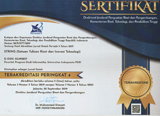Implementasi Algoritma Collision Detection pada Game Simulator Driving Car
(1) Fakultas Teknologi Komunikasi dan Informatika - Universitas Nasional
(2) Universitas Nasional
(3) Universitas Nasional
(*) Corresponding Author
Abstract
Keywords
Full Text:
PDFReferences
Avril, Q. Gouranton, V. & Arnaldi, B. (2014). Collision Detection: Broad Phase Adaptation From. Journal Of Virtual Reality And Broadcasting, Volume N(200n), No. N, 1-14.
Bade, A., Ping, C. S., & Tanalol, S. H. (2015). Collision Detection For Cloth Simulation Using Bounding Sphere Hierarchy. 1-5.
Bhaskara, S. G., Buana, P. W., & Purnawan, I. K. (2017). Permainan Edukasi Labirin Dengan Metode Collision Detection Dan Stereoscopic. Lontar Komputer Vol. 8, No. 2, 65-76.
Heidelberger, B., Teschner, M., & Gross, M. (T.Thn.). Detection Of Collisions And Self-Collisions. 7-8.
Wibawanto, W. (2017). Metode Trigger Detection Untuk Gerakan Kendaraan NPC Dalam Game. Journal of Animation and Games Studies, Vol.3 No.1, 32
Asmiatun, S. (2016). Penerapan Algoritma Collision Detection Dan Bayesian Pada Npc (Non Player Character) Menggunakan Unity 3d. Jurnal Transformatika, Volume 14, 6-11.
ATSC. (2015). “ATSC Standard A/72 Part 1 – VideoSystem Characteristics of AVC in the ATSC DigitalTelevision System”.[Online] Tersedia:https://www.atsc.org/standard/a72-parts- 1-2- and-3/.[23 November 2017].
DOI: http://dx.doi.org/10.30998/string.v3i1.2586
Refbacks
- There are currently no refbacks.
Copyright (c) 2018 STRING (Satuan Tulisan Riset dan Inovasi Teknologi)

This work is licensed under a Creative Commons Attribution 4.0 International License.
STRING (Satuan Tulisan Riset dan Inovasi Teknologi) indexed by:

Ciptaan disebarluaskan di bawah Lisensi Creative Commons Atribusi 4.0 Internasional.
View My Stats

 Sertifikat Akreditasi
Sertifikat Akreditasi
















